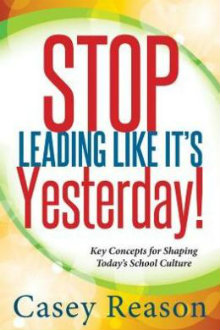How We Can Stop Leading Like Yesterday?
Stop Leading Like It’s Yesterday: Key Concepts for Shaping Today’s School Culture
By Casey Reason
(Solution Tree Press, 2015 – Learn more)
 Reviewed by Tamekia McCauley
Reviewed by Tamekia McCauley
Stop leading like it’s yesterday. What exactly defines “yesterday?” I was curious to know if the definition encompassed the phrase as in years ago or literally yesterday. Considering how much education has changed since I entered the field 13 years ago (I know, I’m still wet behind the ears), I wanted to know if my leadership style could be considered progressive or whether it might be outdated.
I was not familiar with former principal Casey Reason’s work before reading this book, so I was eager to read his viewpoints on educational leadership and was secretly hoping there was a tool or two that I could stash in my toolbox along the way.
What’s in the book
Within the introduction, Reason immediately sets an important ground rule with the reader. If you are a pessimist or reluctant to embrace change this book is not for you. Also, readers are forewarned that his approach to educational reform through research based leadership practices is very no nonsense. This sets the stage for the first example of how to not lead like it is yesterday. Leave your negative attitude at the door.
 Each chapter gives readers an example of “yesterday’s way of thinking” and then immediately offers a new strategy for evoking change. For example, Chapter One begins by encouraging the leader to create a shared vision instead of a vision set primarily by the building leader. Chapter Six gives the reader practical ideas for “igniting next level collaboration” within teams.
Each chapter gives readers an example of “yesterday’s way of thinking” and then immediately offers a new strategy for evoking change. For example, Chapter One begins by encouraging the leader to create a shared vision instead of a vision set primarily by the building leader. Chapter Six gives the reader practical ideas for “igniting next level collaboration” within teams.
Reason reminds the reader how even the functionality of an older building’s design can prohibit collaboration between staff members. He then provides fresh ideas for collaboration including ideas for virtual professional development in a technological age.
Reason also provides the reader with ways to formally assess the strategies he describes. I found this section to be useful because it enables the leader to implement a strategy within the building and then make necessary adjustments based on the research. He often includes interviews with various building leaders which gives the section authenticity.
The author also ends each chapter with the “impact” or the intended outcome from each strategy if implemented successfully.
Having critical conversations
Perhaps my favorite section within each chapter is the critical conversations component. Change is hard for many and often leaders have to facilitate difficult conversations about new or revised initiatives with staff. This section anticipates possible pushback and offers leaders practical tips for engaging staff in critical conversations. The author does not promise harmony, but does provide guidance.
I found myself re-reading and dog-earring several parts of this book. My intent is to approach our district level leaders (using some of Reason’s strategies) during our planning meeting to ask if I can use this book within a cohort study for other building administrators. I’m sure they will agree. I mean they wouldn’t want us leading like it was yesterday, right?
Tamekia McCauley is a middle school administrator in Kansas City, KS. Middle school is her absolute favorite level and she enjoys preparing students for college and career readiness. She has an Ed.D from Baker University and her research interests include educational inequalities and minority teacher recruitment and retention. Follow her @DrTamekia.

































